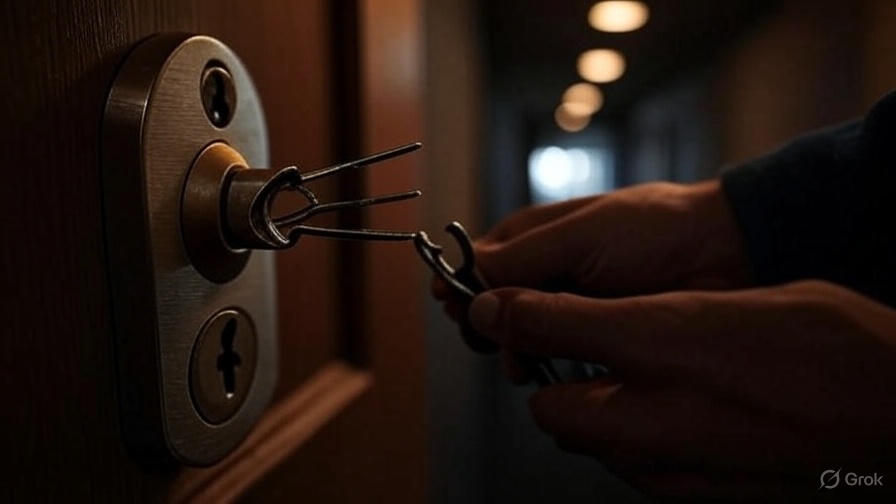How to Break Into a Deadbolt?
Getting locked out of your home can turn any ordinary day into a frustrating nightmare. When you face a stubborn deadbolt standing between you and your belongings, you need practical solutions that actually work. This comprehensive guide covers legitimate methods for gaining entry to your own property during emergency lockout situations.
When Breaking Into Your Own Deadbolt Makes Sense
Emergency situations arise when you least expect them. House fires, medical emergencies, or simply forgetting your keys can leave you stranded outside your own home. Professional locksmiths charge anywhere from $150 to $300 for emergency calls, and waiting times can stretch for hours during peak periods.
Before attempting any entry method, verify you have legal right to access the property. Never attempt these techniques on property you don’t own or have explicit permission to enter. Document your ownership or tenancy status to avoid potential legal complications.
Essential Tools for Deadbolt Entry
The right tools make the difference between success and property damage. Most households contain items that work effectively for emergency entry situations.
Basic Tool Kit:
- Bump keys or lock pick sets
- Heavy-duty screwdriver with flat head
- Drill with metal bits (1/8 inch to 1/2 inch range)
- Hammer (16 oz minimum weight)
- Pry bar or crowbar
- Credit cards or plastic shims
- Paperclips or bobby pins
- Tension wrench alternatives
Professional Grade Options:
- Lock pick gun or electric pick
- Snap gun for pin tumbler locks
- Decoder picks for specific lock types
- High-torque drill with carbide bits
- Hydraulic door spreaders
Lock Picking Techniques That Actually Work
Lock picking remains the most elegant solution for deadbolt entry. Modern deadbolts use pin tumbler mechanisms that respond to proper picking techniques when executed correctly.
Single Pin Picking Method:
Start by inserting your tension wrench into the bottom of the keyway. Apply light rotational pressure in the direction the key would normally turn. Too much pressure binds the pins and prevents proper manipulation.
Insert your pick above the tension wrench and locate the back pin first. Lift each pin until you feel it set at the shear line. The pin clicks slightly when it reaches the correct position. Work from back to front, maintaining consistent tension throughout the process.
Raking Technique for Faster Results:
Raking works well on cheaper deadbolts with loose tolerances. Insert your rake pick and rapidly move it up and down while applying rotational tension. The chaotic motion sometimes bounces pins into the correct positions simultaneously.
This method requires less skill than single pin picking but works inconsistently on high-security locks. Practice the motion beforehand to develop muscle memory for emergency situations.
Bump Key Methods for Pin Tumbler Locks
Bump keys exploit the mechanical design of pin tumbler locks through kinetic energy transfer. A properly cut bump key fits into the lock while leaving all pins at maximum height.
Creating Your Bump Key:
File down a working key for your lock type until all cuts reach maximum depth. The key should enter the lock but not turn without additional manipulation. Professional bump key sets cost around $20-50 and work on multiple lock brands.
Proper Bumping Technique:
Insert the bump key until it seats fully, then pull it back one notch. Apply slight turning pressure while striking the key head with a bump hammer or screwdriver handle. The impact transfers through the key to the pins, causing them to jump momentarily.
Time your turning pressure to catch the brief window when pins align at the shear line. This technique requires practice but works on most standard deadbolts within 30-60 seconds.
Drilling Out Deadbolt Cylinders
Drilling destroys the lock permanently but guarantees entry when other methods fail. Target specific areas of the cylinder to disable the locking mechanism effectively.
Drill Point Selection:
Mark a spot approximately 3/4 inch above the bottom of the keyway. This position aligns with the shear line where pins separate. Use a center punch to prevent drill bit wandering on the hardened steel surface.
Start with a 1/8 inch bit to create your pilot hole. Gradually increase bit sizes up to 3/8 or 1/2 inch depending on the cylinder diameter. The goal involves destroying enough pin material to allow free rotation.
Drilling Process Steps:
Apply cutting oil to reduce heat buildup and extend bit life. Drill at moderate speed with steady pressure. Excessive speed dulls bits quickly on hardened steel cylinders. Stop frequently to clear metal shavings and assess progress.
Insert a screwdriver into the drilled hole and attempt to turn the cylinder. You might need to drill additional holes if pins still bind the mechanism. Some high-security locks require drilling multiple points to disable completely.
Force Entry Techniques for Solid Doors
Sometimes the deadbolt itself proves less vulnerable than the surrounding door frame. Force entry methods target weak points in the door assembly rather than the lock mechanism.
Door Frame Vulnerabilities:
Standard residential door frames use 3/4 inch screws that penetrate only into the thin door jamb. The strike plate absorbs tremendous force during kick attempts, but the screws often fail first.
Examine the gap between door and frame near the deadbolt location. Wide gaps indicate loose installation or settling that creates weak points. Look for signs of previous repairs or reinforcement that might complicate entry attempts.
Proper Kicking Technique:
Position yourself arm’s length from the door with your strong leg forward. Aim your kick at the door handle level, not at the deadbolt itself. The area near the handle provides better leverage against the frame mounting.
Strike with the flat of your foot, not your toes or heel. Drive through the door rather than simply making contact. Multiple controlled strikes work better than one massive attempt that might injure you or damage property unnecessarily.
Pry Bar Applications:
Insert your pry bar between the door and frame near the deadbolt strike plate. Work the bar deeper gradually while applying leverage pressure. The goal involves spreading the frame enough to clear the deadbolt from its receptacle.
Longer pry bars provide better mechanical advantage but require more working space. Place a block of wood behind the pry bar to protect the door frame from excessive damage during the process.
Shimming and Bypass Methods
Some deadbolt installations allow shimming techniques that bypass the locking mechanism entirely. These methods work best on older installations with loose tolerances.
Credit Card Shimming:
This classic technique works only on deadbolts with beveled bolt faces and significant door-to-frame gaps. Insert a flexible plastic card between the door and frame at the latch level.
Angle the card toward the door knob while sliding it down toward the latch mechanism. Apply gentle pressure while wiggling the door handle. The card pushes the latch back into the door, allowing it to open.
Modern deadbolts with square-faced bolts resist this technique completely. The method also fails on doors with tight frame tolerances or weather stripping that blocks card insertion.
Wire and Coat Hanger Methods:
Straighten a coat hanger and create a small hook at one end. Work the wire through gaps around the door frame to reach internal door hardware. Target the door handle linkage or deadbolt release mechanism from inside.
This technique requires significant gaps and knowledge of the internal door mechanism. Success rates vary widely based on door construction and your ability to manipulate hardware blindly.
Professional Lock Bypass Tools
Lock sport enthusiasts and professional locksmiths use specialized tools designed for specific lock types. These tools cost more but work more reliably than improvised alternatives.
Electric Pick Guns:
Electric pick guns vibrate at high frequency to bounce pins rapidly. Set the gun to the appropriate amplitude and trigger duration for your lock type. Insert the pick tip and activate while applying slight turning pressure.
Quality electric picks cost $100-300 but work on most pin tumbler deadbolts within seconds. The technique requires minimal skill development compared to manual picking methods.
Decoder Picks for Wafer Locks:
Some deadbolts use wafer mechanisms instead of pin tumblers. Decoder picks read the wafer positions and provide the correct key combination instantly. Insert the decoder and follow the manufacturer’s instructions for your specific lock brand.
These specialized tools work only on their intended lock types but provide nearly guaranteed results when properly applied.

Security Considerations and Legal Aspects
Breaking into deadbolts carries serious legal implications when performed on property you don’t own. Even legitimate lockout situations can appear suspicious to neighbors or law enforcement officers.
Documentation Requirements:
Keep proof of residence readily available during any entry attempt. Lease agreements, utility bills, or property deeds establish your right to access the property. Inform neighbors of your situation to prevent unnecessary police calls.
Consider calling local police non-emergency lines to report your lockout situation before attempting entry. This creates an official record of your legitimate need for access.
Property Damage Liability:
Most entry techniques cause some level of property damage. Budget for lock replacement costs ranging from $50-200 depending on the security level required. Factor in door frame repairs if force entry methods become necessary.
Rental properties require landlord notification before attempting forced entry. Some lease agreements specify approved locksmiths or entry procedures that tenants must follow during lockout situations.
Prevention Strategies for Future Lockouts
The best deadbolt entry technique involves never needing it in the first place. Simple preparation prevents most lockout situations from occurring.
Key Management Systems:
Hide-a-key products provide emergency access without compromising security significantly. Place hidden keys away from obvious locations like door frames or plant pots. Magnetic key holders work well under vehicle bumpers for automobile access.
Smart locks eliminate physical key requirements while maintaining security levels comparable to traditional deadbolts. Battery backup systems prevent lockouts during power failures.
Access Alternatives:
Install secondary entry points like basement or garage door access. Window security films allow emergency entry while maintaining break-in protection during normal circumstances.
Keypad deadbolts cost slightly more than traditional models but eliminate key-related lockout situations completely. Choose models with mechanical backup systems that function during power outages.
Professional Locksmith Services vs DIY Methods
Professional locksmiths complete most deadbolt entries within 10-15 minutes without property damage. Emergency service calls cost more but preserve your lock and door frame integrity.
When to Call Professionals:
High-security deadbolts with hardened steel components resist most DIY entry attempts. Medeco, Mul-T-Lock, and similar brands require specialized tools and techniques beyond typical household capabilities.
Time-sensitive situations like medical emergencies or security concerns justify professional service costs. Locksmiths carry insurance coverage for accidental property damage during entry attempts.
DIY Success Factors:
Your success depends largely on lock quality, door construction, and available tools. Standard residential deadbolts yield to patient picking or bumping attempts more readily than commercial-grade hardware.
Practice these techniques on locks you own before emergency situations arise. Muscle memory and familiarity with tools make the difference between success and frustration during high-stress lockout scenarios.
Advanced Deadbolt Security Features
Modern deadbolt technology includes features specifically designed to resist the entry methods described in this guide. Understanding these security enhancements helps you choose appropriate techniques for your specific situation.
Anti-Pick Pin Designs:
Spool pins, serrated pins, and mushroom pins create false sets that mislead inexperienced pickers. These pins feel set when they reach the shear line but actually bind the cylinder when turning pressure increases.
Combat these features by using lighter tension and paying attention to feedback from your picks. False sets often require backing off tension and re-setting the binding pin properly.
Drill Resistance Features:
Hardened steel inserts, drill-resistant plates, and free-spinning collars protect cylinder cores from drilling attempts. These features significantly extend drilling time and may require multiple drill bits.
Target alternative areas like the cam mechanism or tailpiece when drilling proves ineffective on the cylinder face. Sometimes disabling the internal mechanism proves easier than destroying the entire cylinder.
Bump Resistance Technology:
Modern deadbolts incorporate bump-resistant features like magnetic pins, sidebar mechanisms, or modified pin chambers that prevent traditional bump key attacks.
These locks require specialized bump keys cut to different specifications or alternative entry methods entirely. Research your specific lock model to determine its bump resistance level.
Emergency Situations and Time Constraints
Real emergency scenarios demand quick decision-making about entry methods. Medical emergencies, fires, or security threats don’t allow time for lengthy picking attempts.
Rapid Entry Priorities:
Force entry methods work fastest when time matters more than property preservation. A kicked-in door costs less than delayed emergency response in life-threatening situations.
Keep a crowbar or similar tool accessible if you frequently face lockout situations. The investment in property damage often proves worthwhile compared to emergency service delays.
Weather Considerations:
Cold temperatures make metal tools brittle and reduce finger dexterity for picking attempts. Rain or snow creates slippery conditions that complicate force entry techniques.
Plan alternative entry points that provide weather protection while you work. Covered porches, garages, or basement entries offer better working conditions during storms.
Conclusion
Deadbolt entry techniques serve legitimate purposes during emergency lockout situations. The methods described here work effectively when applied correctly with proper tools and techniques.
Remember that practice makes perfect with any skill-based technique like lock picking or bumping. Invest time learning these methods before you need them urgently. Keep appropriate tools accessible but secure from potential misuse.
Always verify your legal right to access any property before attempting entry. Document your status as owner or authorized occupant to avoid complications with law enforcement or neighbors.
Consider the cost-benefit analysis of DIY entry versus professional locksmith services. Sometimes paying for expert help costs less than replacing damaged locks and door frames after unsuccessful attempts.
Most importantly, implement prevention strategies that reduce your likelihood of future lockouts. Smart locks, hidden keys, and alternative entry points eliminate most emergency situations before they develop into major problems.
The techniques in this guide provide practical solutions for legitimate access needs. Use them responsibly and only on property you own or have explicit permission to enter.







